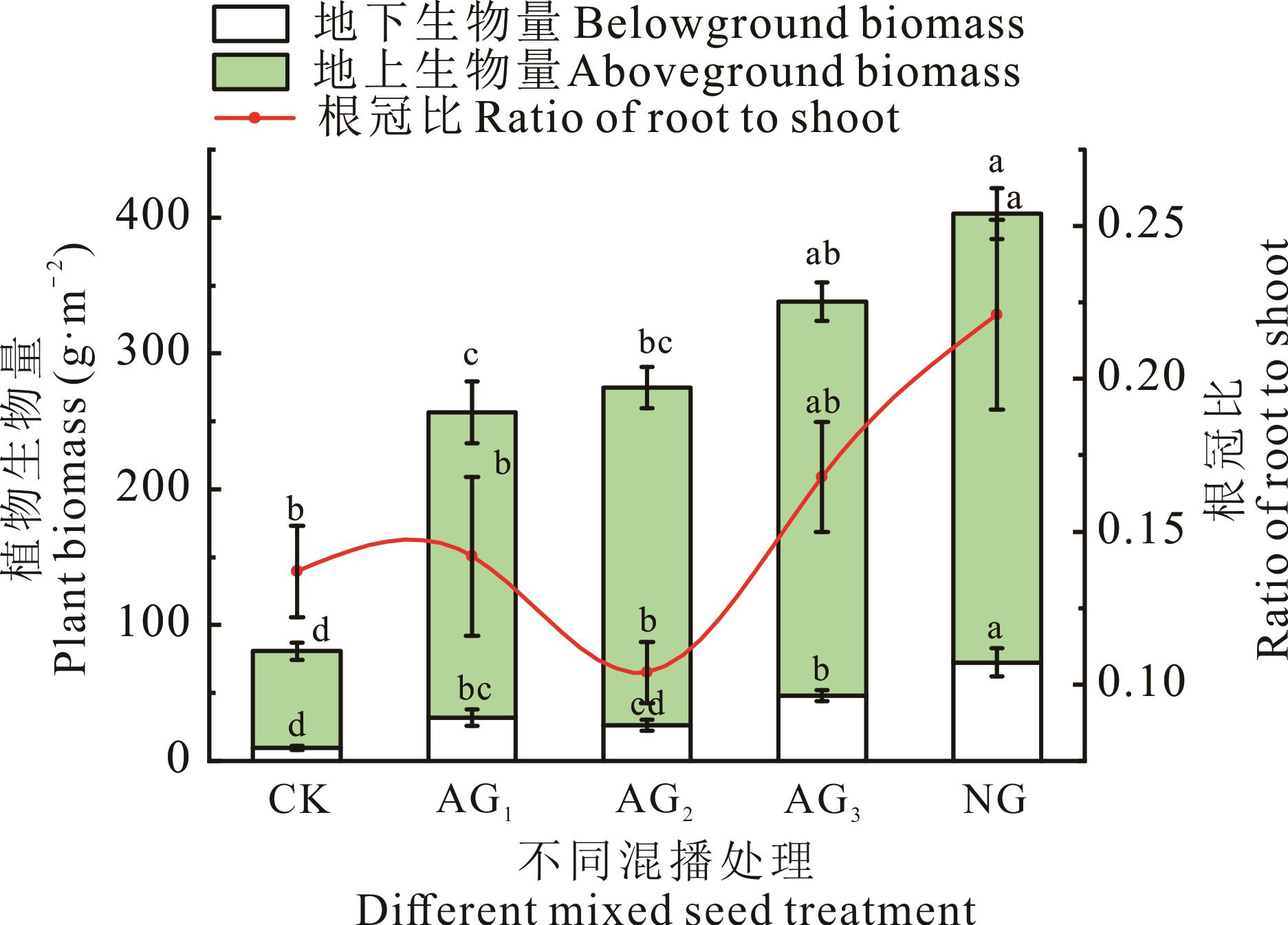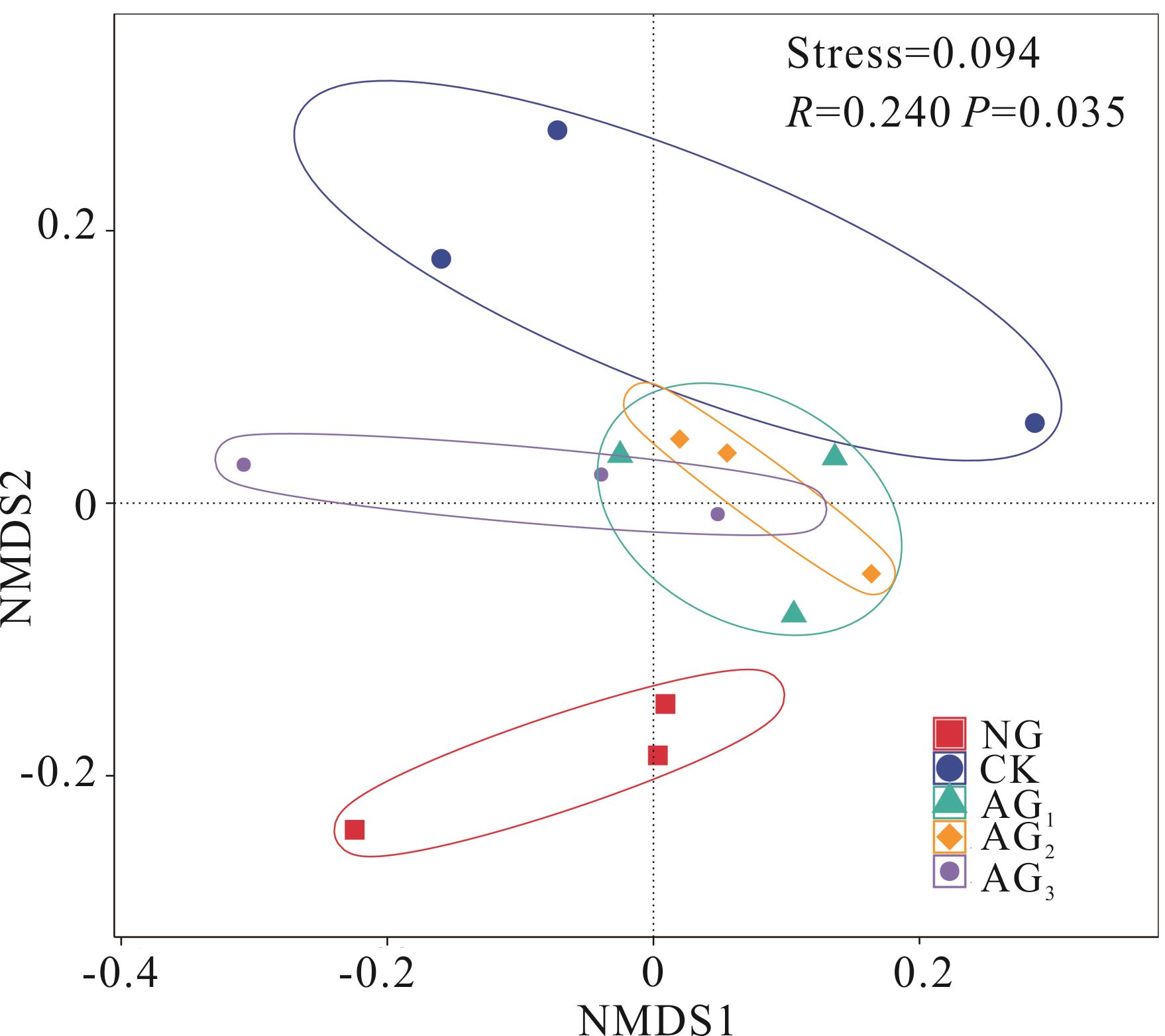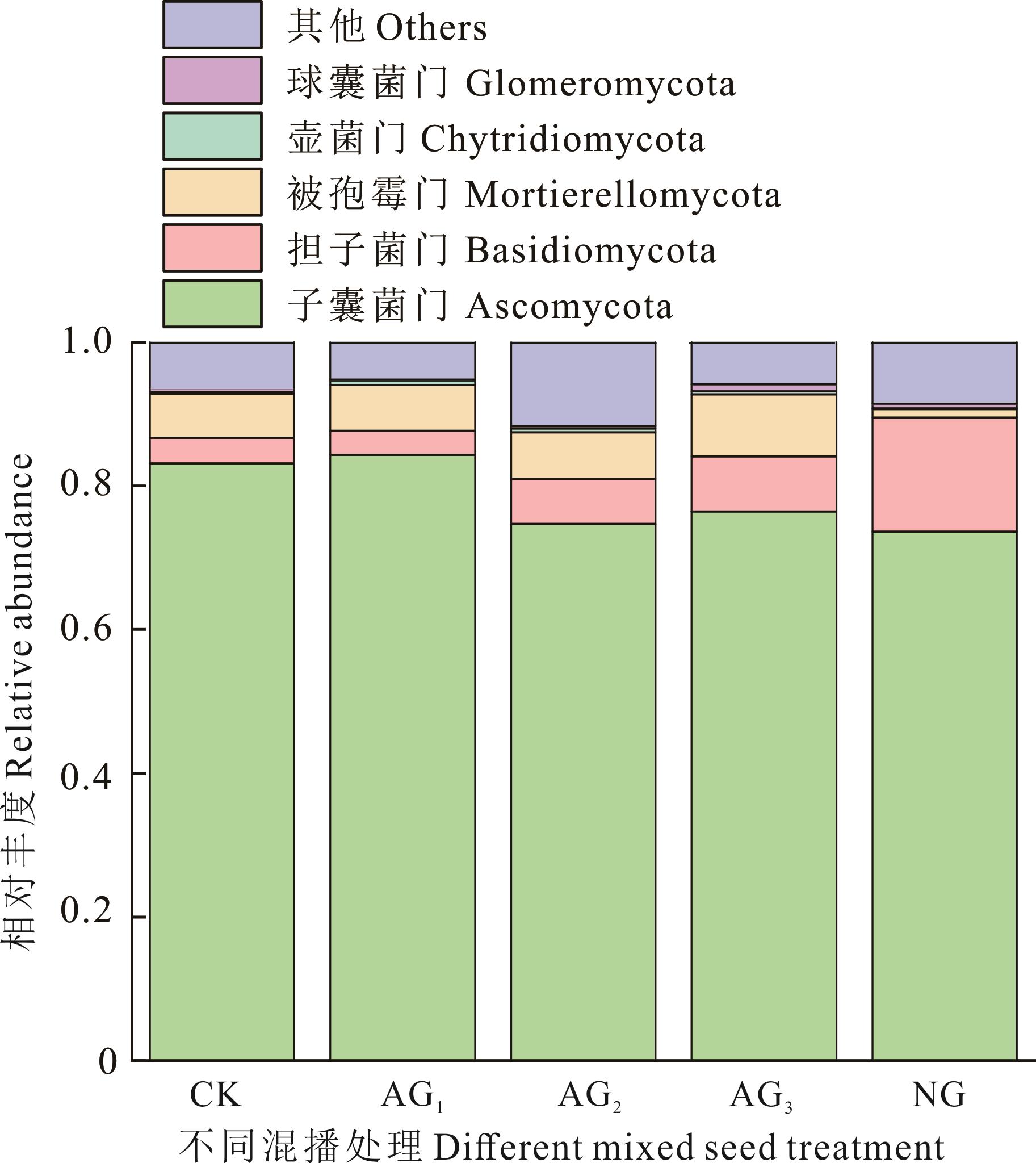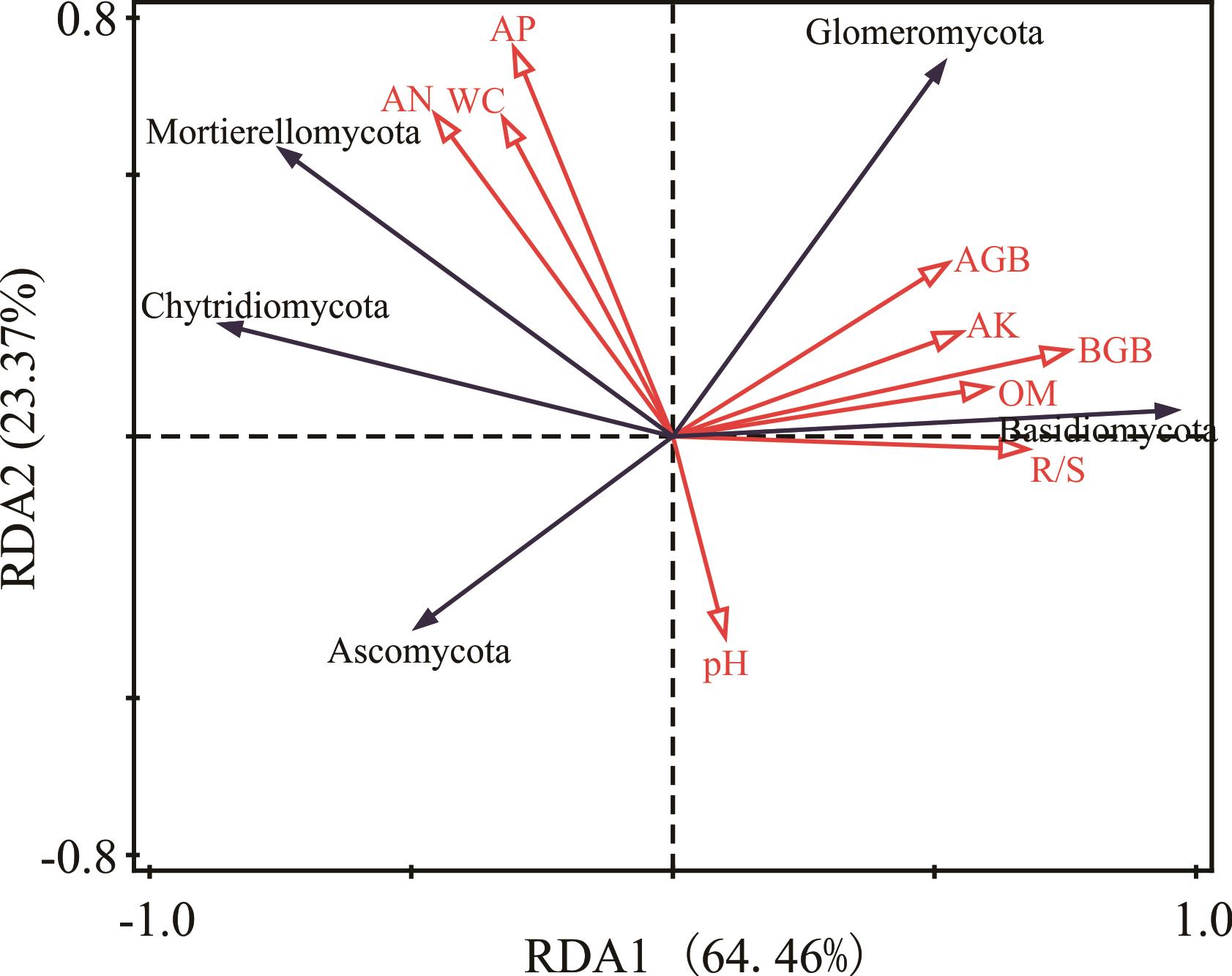

ISSN 1004-5759 CN 62-1105/S


草业学报 ›› 2023, Vol. 32 ›› Issue (6): 45-57.DOI: 10.11686/cyxb2022356
刘欢1( ), 董凯1, 仁增旺堆2, 王敬龙2, 刘云飞2, 赵桂琴1
), 董凯1, 仁增旺堆2, 王敬龙2, 刘云飞2, 赵桂琴1
收稿日期:2022-09-01
修回日期:2022-10-19
出版日期:2023-06-20
发布日期:2023-04-21
通讯作者:
刘欢
作者简介:刘欢(1982-),女,山东招远人,副教授,博士。E-mail: liuhuan@gsau.edu.cn
基金资助:
Huan LIU1( ), Kai DONG1, Zeng-wangdui REN2, Jing-long WANG2, Yun-fei LIU2, Gui-qin ZHAO1
), Kai DONG1, Zeng-wangdui REN2, Jing-long WANG2, Yun-fei LIU2, Gui-qin ZHAO1
Received:2022-09-01
Revised:2022-10-19
Online:2023-06-20
Published:2023-04-21
Contact:
Huan LIU
摘要:
为了明确青藏高原沙化草地的最佳混播修复草种比例及修复过程中的植被-土壤生态环境效应,本研究在西藏沙化草地构建人工修复试验小区,设置了西藏原生种质藏沙蒿及多年生垂穗披碱草和细茎冰草不同比例混播处理,分别为AG1(4︰1︰2),AG2(4︰2︰1),AG3(5︰1︰1),以未修复沙化裸地为对照(CK),同时以原位条件下天然草地(NG)做比较。种植试验开展3年后,测定植被生物量、土壤理化性质指标,同时采用ITS测序技术和FUNGuild功能预测的方法,研究土壤真菌的群落结构及功能的变化规律。结果表明: 1)与未修复沙化土地相比,混播修复3年的各处理可使地上生物量(AGB)和地下生物量(BGB)提高3倍以上,并显著增加土壤含水量(WC)、有机质(OM)、碱解氮(AN)、有效磷(AP)和速效钾(AK)含量 (P<0.05)。2)AG3处理下土壤真菌多样性最高,真菌群落结构与天然草地最相似。3)各沙化修复处理与NG间土壤中的担子菌门和被孢霉门存在显著差异(P<0.05)。冗余分析结果显示,BGB、AN、AP和pH是影响土壤真菌门水平群落结构的主要环境因子,担子菌门的相对丰度与BGB和pH呈正相关,被孢霉门的相对丰度与BGB、AN和AP呈正相关。4)基于FUNGuild功能预测,所有土壤样品中检测出腐生、病理和共生3类营养型和5类交叉营养型功能菌群,其中病理型、腐生型、病理-腐生型、病理-腐生-共生型和共生型为主要的营养型。由此可见,藏沙蒿与多年生禾草垂穗披碱草和细茎冰草混播有提高沙化草地植物生物量的作用,三者按5︰1︰1混播的修复土壤效果最优,可以有效改善土壤养分和真菌丰富度,从而改变土壤真菌群落结构和功能。
刘欢, 董凯, 仁增旺堆, 王敬龙, 刘云飞, 赵桂琴. 藏沙蒿与多年生禾草混播对西藏沙化草地植被及土壤真菌群落特征的影响[J]. 草业学报, 2023, 32(6): 45-57.
Huan LIU, Kai DONG, Zeng-wangdui REN, Jing-long WANG, Yun-fei LIU, Gui-qin ZHAO. Effects of co-sowing of Artemisia wellbyi and perennial grasses on the characteristics of vegetation and soil fungal communities in desertified grasslands in Tibet[J]. Acta Prataculturae Sinica, 2023, 32(6): 45-57.
样地 Sample plot | 混播比例 Mixed ratio | 总播种量 Sowing amount (g·m-2) |
|---|---|---|
| CK | 未修复沙化草地 Unrestored sandy grassland | 0 |
| NG | 天然草地Natural grassland | 0 |
| AG1 | 4︰1︰2 | 1.479 |
| AG2 | 4︰2︰1 | 1.479 |
| AG3 | 5︰1︰1 | 1.286 |
表1 试验处理及对照
Table 1 Experimental treatment and control
样地 Sample plot | 混播比例 Mixed ratio | 总播种量 Sowing amount (g·m-2) |
|---|---|---|
| CK | 未修复沙化草地 Unrestored sandy grassland | 0 |
| NG | 天然草地Natural grassland | 0 |
| AG1 | 4︰1︰2 | 1.479 |
| AG2 | 4︰2︰1 | 1.479 |
| AG3 | 5︰1︰1 | 1.286 |

图2 不同比例混播修复对植物生物量的影响不同小写字母分别表示同一指标不同处理之间差异显著(P<0.05),下同。Different lowercase letters indicate significant differences among different treatments under same indicators (P<0.05), the same below.
Fig. 2 Effects of different proportions of mixed sowing remediation on plants biomass allocation

图3 不同比例混播修复对土壤理化特征的影响图A、B、C、D、E和F分别代表不同处理下土壤含水量、pH及有机质、碱解氮、有效磷和速效钾含量。A, B, C, D, E and F represent the soil water content, pH and content of organic matter, alkali-hydrolyzale nitrogen, available phosphorus and available potassium under different treatments.
Fig. 3 Effects of different proportions of mixed sowing remediation on soil physical and chemical properties
| 样地Sample plot | Chao1指数Chao1 index | 物种数目Observed species | Shannon指数Shannon index | Simpson指数Simpson index |
|---|---|---|---|---|
| CK | 520.61±74.76a | 515.67±71.49a | 6.52±0.40ab | 0.97±0.009a |
| AG1 | 454.54±81.48a | 453.00±81.90a | 4.92±0.89b | 0.86±0.056b |
| AG2 | 441.33±62.44a | 440.00±62.55a | 5.31±0.34b | 0.91±0.009ab |
| AG3 | 581.46±43.14a | 580.00±42.67a | 7.07±0.27a | 0.98±0.008a |
| NG | 471.12±13.94a | 466.67±12.02a | 5.55±0.04ab | 0.93±0.003ab |
表2 不同比例混播下土壤真菌群落Alpha多样性指数
Table 2 Alpha diversity index of soil fungal community under different proportions of mixed sowing
| 样地Sample plot | Chao1指数Chao1 index | 物种数目Observed species | Shannon指数Shannon index | Simpson指数Simpson index |
|---|---|---|---|---|
| CK | 520.61±74.76a | 515.67±71.49a | 6.52±0.40ab | 0.97±0.009a |
| AG1 | 454.54±81.48a | 453.00±81.90a | 4.92±0.89b | 0.86±0.056b |
| AG2 | 441.33±62.44a | 440.00±62.55a | 5.31±0.34b | 0.91±0.009ab |
| AG3 | 581.46±43.14a | 580.00±42.67a | 7.07±0.27a | 0.98±0.008a |
| NG | 471.12±13.94a | 466.67±12.02a | 5.55±0.04ab | 0.93±0.003ab |

图5 不同比例混播处理下真菌群落结构的非度量多维尺度(NMDS)分析
Fig.5 Non-metric multidimensional scaling analysis of fungal community structure under different proportions of mixed seeding treatments

图6 不同比例混播修复下土壤真菌群落在门水平的相对丰度
Fig.6 Relative abundance of soil fungal communities at the phylum level under different proportions of mixed seeding restoration

图7 土壤真菌门水平群落结构与土壤理化性质的冗余分析WC: 含水量Water content; OM: 有机质Organic matter; AN: 碱解氮Alkali-hydrolyzale nitrogen; AP: 有效磷Available phosphorus; AK: 速效钾Available potassium; AGB: 地上生物量Aboveground biomass; BGB: 地下生物量Belowground biomass; R/S: 根冠比Ratio of root to shoot; Ascomycota: 子囊菌门; Basidiomycota: 担子菌门; Mortierellomycota: 被孢霉门; Chytridiomycota: 壶菌门; Glomeromycota: 球囊菌门.
Fig.7 Redundancy analysis of soil fungal communities at the phylum level and soil physicochemical properties
指标 Index | 解释度 Explains (%) | 贡献率 Contribution (%) | F | P |
|---|---|---|---|---|
| BGB | 32.8 | 38.8 | 6.3 | 0.006 |
| AN | 23.4 | 27.7 | 6.4 | 0.002 |
| AP | 10.8 | 12.8 | 3.6 | 0.028 |
| pH | 8.8 | 10.4 | 3.6 | 0.016 |
| AGB | 4.0 | 4.7 | 1.8 | 0.176 |
| R/S | 1.3 | 1.5 | 0.5 | 0.686 |
| WC | 1.5 | 1.8 | 0.6 | 0.630 |
| OM | 1.3 | 1.5 | 0.5 | 0.666 |
| AK | 0.7 | 0.9 | 0.2 | 0.852 |
表3 土壤理化性质对真菌群落结构的影响
Table 3 Effects of soil physicochemical properties on fungal community structure
指标 Index | 解释度 Explains (%) | 贡献率 Contribution (%) | F | P |
|---|---|---|---|---|
| BGB | 32.8 | 38.8 | 6.3 | 0.006 |
| AN | 23.4 | 27.7 | 6.4 | 0.002 |
| AP | 10.8 | 12.8 | 3.6 | 0.028 |
| pH | 8.8 | 10.4 | 3.6 | 0.016 |
| AGB | 4.0 | 4.7 | 1.8 | 0.176 |
| R/S | 1.3 | 1.5 | 0.5 | 0.686 |
| WC | 1.5 | 1.8 | 0.6 | 0.630 |
| OM | 1.3 | 1.5 | 0.5 | 0.666 |
| AK | 0.7 | 0.9 | 0.2 | 0.852 |
| 真菌营养型Fungal trophic type | P | 真菌营养型Fungal trophic type | P |
|---|---|---|---|
| 未定义Unassigned | 0.228 | 共生营养型Symbiotic nutrient type | 0.043 |
| 病理营养型Pathological nutrient type | 0.049 | 病理-共生营养型Pathotroph-symbiotroph | 0.106 |
| 腐生营养型Saprophytic nutrient type | 0.124 | 腐生-共生营养型Saprotroph-symbiotroph | 0.498 |
| 病理-腐生营养型Pathotroph-saprotroph | 0.234 | 病原-腐生-共生营养型Pathogen-saprotroph-symbiotroph | 0.640 |
| 病理-腐生-共生营养型Pathotroph-saprotroph-symbiotroph | 0.323 |
表4 真菌营养型wilcoxon秩和检验结果
Table 4 Result of wilcoxon rank sum test for fungal trophic type
| 真菌营养型Fungal trophic type | P | 真菌营养型Fungal trophic type | P |
|---|---|---|---|
| 未定义Unassigned | 0.228 | 共生营养型Symbiotic nutrient type | 0.043 |
| 病理营养型Pathological nutrient type | 0.049 | 病理-共生营养型Pathotroph-symbiotroph | 0.106 |
| 腐生营养型Saprophytic nutrient type | 0.124 | 腐生-共生营养型Saprotroph-symbiotroph | 0.498 |
| 病理-腐生营养型Pathotroph-saprotroph | 0.234 | 病原-腐生-共生营养型Pathogen-saprotroph-symbiotroph | 0.640 |
| 病理-腐生-共生营养型Pathotroph-saprotroph-symbiotroph | 0.323 |
| 1 | Song G Y, Bianba Z M. Test on forage introduction adaptability on desertification land in the middle of the Yarlung Zangbo river basin. Modern Agricultural Science and Technology, 2022(9): 171-174. |
| 宋国英, 边巴卓玛. 雅鲁藏布江中部流域沙化地牧草引种适应性试验. 现代农业科技, 2022(9): 171-174. | |
| 2 | Tu Z F, Li M X, Sun T. The status and trend analysis of desertification and sandification. Forest Resources Management, 2016(1): 1-5, 13. |
| 屠志方, 李梦先, 孙涛. 第五次全国荒漠化和沙化监测结果及分析. 林业资源管理, 2016(1): 1-5, 13. | |
| 3 | Ning X B, Liu W, Wu X B, et al. Genesis analysis of desertified land in Tibet. Central South Forest Inventory and Planning, 2022, 41(1): 66-70. |
| 宁小斌, 刘伟, 吴协保, 等. 西藏自治区沙化土地成因分析. 中南林业调查规划, 2022, 41(1): 66-70. | |
| 4 | Li X P, Li J H, Liu Y G, et al. The vegetation and soil microorganism characteristics of different degraded grassland in Gannan steppe. Acta Agrestia Sinica, 2020, 28(5): 1252-1259. |
| 李雪萍, 李建宏, 刘永刚, 等. 甘南草原不同退化草地植被和土壤微生物特性. 草地学报, 2020, 28(5): 1252-1259. | |
| 5 | Zhang Z M, Han X Z, Yan J, et al. Keystone microbiomes revealed by 14 years of field restoration of the degraded agricultural soil under distinct vegetation scenarios. Frontiers in Microbiology, 2020, 11: 1915. |
| 6 | Li H D, Gao J X, Hu Q W, et al. Assessing revegetation effectiveness on an extremely degraded grassland, southern Qinghai-Tibetan Plateau, using terrestrial Li DAR and field data. Agriculture, Ecosystems & Environment, 2019, 282: 13-22. |
| 7 | Shen W S, Li H D, Lin N F, et al. Screening trial for the suitable plant species growing on sand dunes in the alpine valley and its recovery status in the Yarlung Zangbo River basin of Tibet, China. Acta Ecologica Sinica, 2012, 32(17): 5609-5618. |
| 沈渭寿, 李海东, 林乃峰, 等. 雅鲁藏布江高寒河谷流动沙地适生植物种筛选和恢复效果. 生态学报, 2012, 32(17): 5609-5618. | |
| 8 | Xu K, Wang X, Wang J, et al. Effectiveness of protection areas in safeguarding biodiversity and ecosystem services in Tibet Autonomous Region. Scientific Reports, 2022, 12(1): 1161. |
| 9 | Xie L L. Adaptability evaluation of cultivation grass seed in black soil mountain of degraded grassland in the source area of three rivers. Xining: Qinghai University, 2021. |
| 谢乐乐. 三江源区“黑土山”退化草地栽培草种适应性评价. 西宁: 青海大学, 2021. | |
| 10 | Ren K, Guo K, Zheng J M, et al. Growth of four herbaceous species in different mixing modes for restoration of desertificated grassland around Cuona Lake, Tibet. Acta Ecologica Sinica, 2020, 40(3): 910-920. |
| 任康, 郭坤, 郑景明, 等. 四种草本植物混播处理在西藏措那湖沙害区植被恢复中的表现. 生态学报, 2020, 40(3): 910-920. | |
| 11 | Qiu Y S, Zheng Y Y, Xie W G. Advances in genetics and breeding of Elymus nutans in China. Chinese Journal of Grassland, 2022, 44(2): 98-106. |
| 邱涌森, 郑玉莹, 谢文刚. 我国垂穗披碱草遗传育种研究进展. 中国草地学报, 2022, 44(2): 98-106. | |
| 12 | Li S X, Liu Y B, Yu D M, et al. Research on mechanical characteistics of two herbaceous roots under salt stress in cold and arid environment. Journal of Salt Lake Research, 2019, 27(1): 116-131. |
| 李淑霞, 刘亚斌, 余冬梅, 等. 寒旱环境盐胁迫条件下两种草本植物的根系力学特性研究. 盐湖研究, 2019, 27(1): 116-131. | |
| 13 | Luo J M, Liu H, Wang J L, et al. Screening and evaluation of methods for breaking seed dormancy of wild Artemisia wellbyi. Acta Agrestia Sinica, 2022, 30(6): 1606-1612. |
| 罗建民, 刘欢, 王敬龙, 等. 打破野生藏沙蒿种子休眠方法的筛选与评价. 草地学报, 2022, 30(6): 1606-1612. | |
| 14 | Liao C R, Lv G P, Wang T, et al. Plant species diversity of vegetation restoration of moving sandy on flood plain in Tibet, China. Journal of Nanjing Forestry University, 2018, 42(2): 89-96. |
| 廖承锐, 吕国屏, 王涛, 等. 西藏河滩流动沙地植被恢复及物种多样性变化. 南京林业大学学报, 2018, 42(2): 89-96. | |
| 15 | Peay K G, Kennedy P G, Talbot J M. Dimensions of biodiversity in the earth mycobiome. Nature Reviews Microbiology, 2016, 14(7): 434-447. |
| 16 | Chen C, Chen H Y H, Chen X L, et al. Meta-analysis shows positive effects of plant diversity on microbial biomass and respiration. Nature Communications, 2019, 10(1): 1332. |
| 17 | Lang S X, Hu S J, Li M, et al. Ecological restoration measures improved carbon sequestration of desertification grassland ecosystem in alpine area. Environmental Science & Technology, 2021, 44(4): 149-157. |
| 郎山鑫, 胡嗣佳, 李梦, 等. 生态恢复措施提升高寒沙化草地的固碳效应. 环境科学与技术, 2021, 44(4): 149-157. | |
| 18 | Hu J J, Zhou Q P, Lv Y H, et al. Comparison study to the effectiveness of typical ecological restoration measures in semi-humid sandy land in eastern Qinghai-Tibetan Plateau, China. Acta Ecologica Sinica, 2020, 40(20): 7410-7418. |
| 胡金娇, 周青平, 吕一河, 等. 青藏高原东缘半湿润沙地典型生态恢复模式的效果比较研究. 生态学报, 2020, 40(20): 7410-7418. | |
| 19 | Zhalnina K, Louie K B, Hao Z, et al. Dynamic root exudate chemistry and microbial substrate preferences drive patterns in rhizosphere microbial community assembly. Nature Microbiology, 2018, 3(4): 470-480. |
| 20 | Wei X, Shi Y, Qin F, et al. Effects of experimental warming, precipitation increase and their interaction on AM fungal community in an alpine grassland of the Qinghai-Tibetan Plateau. European Journal of Soil Biology, 2021, 102: 103272. |
| 21 | Yang H, Wang P Y, Li X W, et al. Distribution of soil fungal diversity and community structure in different vegetation types on the eastern slopes of Helan Mountains. Ecology and Environmental Sciences, 2022, 31(2): 239-247. |
| 杨虎, 王佩瑶, 李小伟, 等. 贺兰山东坡不同植被类型的土壤真菌多样性及其群落结构. 生态环境学报, 2022, 31(2): 239-247. | |
| 22 | Wang L Y, Zhou C, Liu G Z, et al. Variation of arbuscular mycorrhiza fungal communities in the rhizosphere soil of Phoebe bournei (Hemsl.) Yang plantations based on high-throughput sequencing analysis. Microbiology China, 2021, 48(5): 1461-1472. |
| 王丽艳, 周晨, 刘光正, 等. 基于高通量测序的闽楠幼林根际土壤丛枝菌根真菌群落变化. 微生物学通报, 2021, 48(5): 1461-1472. | |
| 23 | Bao S D. Soil agrochemical analysis. Beijing: China Agriculture Press, 1999. |
| 鲍士旦. 土壤农化分析. 北京: 中国农业出版社, 1999. | |
| 24 | Griffiths R I, Whiteley A S, O’Donnel A G, et al. Rapid method for coextraction of DNA and RNA from natural environments for analysis of ribosomal DNA and RNA based microbial community composition. Applied and Environmental Microbiology, 2000, 66(12): 5488-5491. |
| 25 | Haas B J, Gever D, Earl A M, et al. Chimeric 16S rRNA sequence formation and detection in Sanger and 454-pyrosequenced PCR amplicons. Genome Research, 2011, 21(3): 494-504. |
| 26 | Callahan B J, McMurdie P J, Holmes S P, et al. Exact sequence variants should replace operational taxonomic units in marker-gene data analysis. The ISME Journal, 2017, 11(12): 2639-2643. |
| 27 | Zhang C, Yan R R, Liang Q W, et al. Study on soil physical and chemical properties and carbon and nitrogen sequestration of grassland under different utilization modes. Acta Prataculturae Sinica, 2021, 30(4): 90-98. |
| 张超, 闫瑞瑞, 梁庆伟, 等. 不同利用方式下草地土壤理化性质及碳、氮固持研究. 草业学报, 2021, 30(4): 90-98. | |
| 28 | Liu L, Zeng K, Wu N, et al. Variation in physicochemical and biochemical soil properties among different plant species treatments early in the restoration of a desertified alpine meadow. Land Degradation & Development, 2019, 30(16): 1889-1903. |
| 29 | Wu G L, Liu Z H, Zhang L, et al. Effects of artificial grassland establishment on soil nutrients and carbon properties in a black-soil-type degraded grassland. Plant and Soil, 2010, 333(1): 469-479. |
| 30 | Beimforde C, Feldberg K, Nylinder S, et al. Estimating the phanerozoic history of the Ascomycota lineages: Combining fossil and molecular data. Molecular Phylogenetics and Evolution, 2014, 78: 386-398. |
| 31 | Yang S, Yang W P, Jing D D, et al. Improvement of soil microbial community structure by multiple cropping alfalfa after wheat. Chinese Journal of Applied and Environmental Biology, 2021, 27(4): 978-987. |
| 杨思, 杨文平, 景豆豆, 等. 麦后复种苜蓿压青还田改善土壤微生物群落结构. 应用与环境生物学报, 2021, 27(4): 978-987. | |
| 32 | Hu L, Robert C A M, Cadot S, et al. Root exudate metabolites drive plant-soil feedbacks on growth and defense by shaping the rhizosphere microbiota. Nature Communications, 2018, 9(1): 1-13. |
| 33 | Li Y, Wang S, Jiang L, et al. Changes of soil microbial community under different degraded gradients of alpine meadow. Agriculture, Ecosystems & Environment, 2016, 222: 213-222. |
| 34 | Chang X X, Chen H S, Li Z G, et al. Species diversity of ecological restoration plant communities in typical desert areas of the Brahmaputra River Basin in Tibet. Journal of Desert Research, 2021, 41(6): 187-194. |
| 常学向, 陈怀顺, 李志刚, 等. 西藏雅鲁藏布江流域典型沙漠区生态修复植物群落物种多样性. 中国沙漠, 2021, 41(6): 187-194. | |
| 35 | Yang F L, Shi Y, Li B, et al. Status and prospects of the application of root exudates in the restoration of polluted or desertated soil. Chinese Journal of Applied Ecology, 2021, 32(7): 2623-2632. |
| 杨富玲, 石杨, 李斌, 等. 植物根系分泌物在污染及沙化土壤修复中的应用现状与前景. 应用生态学报, 2021, 32(7): 2623-2632. | |
| 36 | Cheema S A, Khan M I, Tang X, et al. Surfactant enhanced pyrene degradation in the rhizosphere of tall fescue (Festuca arundinacea). Environmental Science and Pollution Research, 2016, 23(18): 18129-18136. |
| 37 | Zhao X G, Zhang S T, Niu K C. Relationships between soil fungal diversity, plant community functional traits, and soil attributes in Tibetan alpine meadows. Chinese Journal of Applied and Environmental Biology, 2020, 26(1): 1-9. |
| 赵兴鸽, 张世挺, 牛克昌. 青藏高原高寒草甸土壤真菌多样性与植物群落功能性状和土壤理化特性的关系. 应用与环境生物学报, 2020, 26(1): 1-9. | |
| 38 | Li J, Wei X Y, Tang M. Effects of different plants on soil microbial biomass and enzyme activities in Zhifanggou Watershed of Loess Plateau. Acta Botanica Boreali-Occidentalia Sinica, 2013, 33(2): 387-393. |
| 李静, 蔚晓燕, 唐明. 黄土高原纸坊沟流域不同植物对土壤微生物生物量和土壤酶活性的影响. 西北植物学报, 2013, 33(2): 387-393. | |
| 39 | Zhang J X, Wang Z Q, Quan X L, et al. Responses of soil microbial communities of sown perennial grassland in alpine region to different sowing ways and growth years. Acta Agrestia Sinica, 2021, 29(2): 270-280. |
| 张杰雪, 王占青, 全小龙, 等. 高寒地区人工草地土壤微生物群落对不同种植方式和年限的响应. 草地学报, 2021, 29(2): 270-280. | |
| 40 | Wang C, Liu Z, Wang Z, et al. Effects of autotoxicity and allelopathy on seed germination and seedling growth in Medicago truncatula. Frontiers in Plant Science, 2022, 13: 908426. |
| 41 | Rong X S, He M, Wang C Y, et al. Analysis on the diversity of soil bacterial and fungal communities in the degraded alpine grassland in Northern Tibet Plateau. Ecology and Environmental Sciences, 2018, 27(9): 1646-1651. |
| 荣新山, 何敏, 王从彦, 等. 藏北退化高寒草原土壤细菌和真菌多样性分析. 生态环境学报, 2018, 27(9): 1646-1651. | |
| 42 | Wang Z Y, Liu B R, Mou H X, et al. Diversity characteristics at different development stages of Caragana korshinskii Kom. Nebkhas in the desert steppe. Agricultural Research in the Arid Areas, 2022, 40(3): 218-227. |
| 王子寅, 刘秉儒, 牟红霞, 等. 荒漠草原不同发育阶段柠条灌丛堆土壤真菌群落多样性特征研究. 干旱地区农业研究, 2022, 40(3): 218-227. | |
| 43 | Wu W X, Zhang L, Huang X Q, et al. Difference in soil microbial diversity in artificial grasslands of the Northwest Plateau of Sichuan Province. Acta Prataculturae Sinica, 2019, 28(3): 29-41. |
| 伍文宪, 张蕾, 黄小琴, 等. 川西北高寒牧区不同人工草地对土壤微生物多样性影响. 草业学报, 2019, 28(3): 29-41. | |
| 44 | Maharachchikumbura S S N, Hyde K D, Jones E B, et al. Towards a natural classification and backbone tree for Sordariomycetes. Fungal Diversity, 2015, 72(1): 199-301. |
| 45 | Yuan J, Wen T, Zhang H, et al. Predicting disease occurrence with high accuracy based on soil macroecological patterns of Fusarium wilt. The ISME Journal, 2020, 14(12): 2936-2950. |
| 46 | Lienhard P, Terrat S, Prévost-Bouré N C, et al. Pyrosequencing evidences the impact of cropping on soil bacterial and fungal diversity in Laos tropical grassland. Agronomy for Sustainable Development, 2014, 34(2): 525-533. |
| 47 | Treseder K K, Lennon J T. Fungal traits that drive ecosystem dynamics on land. Microbiology and Molecular Biology Reviews, 2015, 79(2): 243-262. |
| 48 | Zhang S M, Huang Y M, Ni Y X, et al. Effects of artificial forest and grass on soil fungal community at southern Ningxia mountain. China Environmental Science, 2018, 38(4): 1449-1458. |
| 张树萌, 黄懿梅, 倪银霞, 等. 宁南山区人工林草对土壤真菌群落的影响. 中国环境科学, 2018, 38(4): 1449-1458. | |
| 49 | Lauber C L, Strickland M S, Bradford M A, et al. The influence of soil properties on the structure of bacterial and fungal communities across land-use types. Soil Biology and Biochemistry, 2008, 40(9): 2407-2415. |
| 50 | Geng D Z, Huang J H, Huo N, et al. Characteristics of soil microbial and nematode communities under artificial Medicago sativa grasslands with different cultivation years in semi-arid region of Loess Plateau, northwest China. Chinese Journal of Applied Ecology, 2020, 31(4): 1365-1377. |
| 耿德洲, 黄菁华, 霍娜, 等. 黄土高原半干旱区不同种植年限紫花苜蓿人工草地土壤微生物和线虫群落特征. 应用生态学报, 2020, 31(4): 1365-1377. | |
| 51 | Yin Y L, Li S X, Ma Y S. Effects of replanting on soil fungal community characteristics in degraded alpine meadow. Acta Agrestia Sinica, 2020, 28(6): 1791-1797. |
| 尹亚丽, 李世雄, 马玉寿. 人工补播对退化高寒草甸土壤真菌群落特征的影响. 草地学报, 2020, 28(6): 1791-1797. | |
| 52 | Zheng Q, Hu Y, Zhang S, et al. Soil multifunctionality is affected by the soil environment and by microbial community composition and diversity. Soil Biology and Biochemistry, 2019, 136: 107521. |
| 53 | Wang Y N, Hu Y G, Wang Z R, et al. Impacts of artificial revegetation on soil fungal community in desertified alpine grassland. 2022-06-09. http://kns.cnki.net/kcms/detail/32.1119.P.20211208.1558.002.html. |
| 王亚妮, 胡宜刚, 王增如, 等. 人工植被重建对沙化高寒草地土壤真菌群落特征的影响. 2022-06-09. http://kns.cnki.net/kcms/ detail/32.1119.P.20211208.1558.002.html. |
| [1] | 史正军, 潘松, 冯世秀, 袁峰均. 园林废弃物地表覆盖处理对植物生长及土壤细菌群落的影响[J]. 草业学报, 2023, 32(4): 153-160. |
| [2] | 彭艳, 孙晶远, 马素洁, 王向涛, 魏学红, 孙磊. 藏北不同退化阶段高寒草甸植物群落特征与土壤养分特性[J]. 草业学报, 2022, 31(8): 49-60. |
| [3] | 田英, 许喆, 朱丽珍, 王俊, 温学飞. 生长季不同月份平茬对柠条人工林地土壤细菌群落特性的影响[J]. 草业学报, 2022, 31(5): 40-50. |
| [4] | 潘占东, 马倩倩, 陈晓龙, 蔡立群, 蔡雪梅, 董博, 武均, 张仁陟. 添加生物质炭对黄土高原旱作农田土壤养分、腐殖质及其组分的影响[J]. 草业学报, 2022, 31(2): 14-24. |
| [5] | 闫晓红, 牛建明, 李元恒, 伊风艳, 孙世贤, 金轲, 李西良. 物种优先效应对植物群落构建的影响及其生态恢复意义[J]. 草业学报, 2022, 31(10): 217-225. |
| [6] | 王永宏, 田黎明, 艾鷖, 陈仕勇, 泽让东科. 短期牦牛放牧对青藏高原高寒草地土壤真菌群落的影响[J]. 草业学报, 2022, 31(10): 41-52. |
| [7] | 靳旭妹, 王莹莹, 刘崇义, 陈新义, 龙明秀, 何树斌. 生草对关中地区有机猕猴桃园土壤养分及细菌群落的影响[J]. 草业学报, 2022, 31(10): 53-63. |
| [8] | 张永超, 梁国玲, 秦燕, 刘文辉, 贾志锋, 刘勇, 马祥. 老芒麦衰老过程中叶片叶绿素和光合作用变化特征及对养分的响应[J]. 草业学报, 2022, 31(1): 229-237. |
| [9] | 任军, 石遥, 刘方, 田蓉, 刘兴. 贵州锰矿废渣堆场重金属污染风险评价及草本植物重金属吸收特征[J]. 草业学报, 2021, 30(8): 86-97. |
| [10] | 马欣, 罗珠珠, 张耀全, 刘家鹤, 牛伊宁, 蔡立群. 黄土高原雨养区不同种植年限紫花苜蓿土壤细菌群落特征与生态功能预测[J]. 草业学报, 2021, 30(3): 54-67. |
| [11] | 李文, 魏廷虎, 永措巴占, 才仁塔次, 周玉海, 张雁平, 李文浩, 郭卫兴. 混播比例对三江源人工草地植被和土壤养分特征的影响[J]. 草业学报, 2021, 30(12): 39-48. |
| [12] | 周诗晶, 罗佳宁, 刘仲淼, 董超, 秦燕, 吴淑娟, 甘红军, 谢菲, 庄光辉, 伏兵哲, 牛得草. 箭筈豌豆种植密度对土壤微生物养分代谢的影响[J]. 草业学报, 2021, 30(10): 63-72. |
| [13] | 韩福贵, 满多清, 郑庆钟, 赵艳丽, 张裕年, 肖斌, 付贵全, 杜娟. 青土湖典型湿地白刺灌丛沙堆群落物种多样性及土壤养分变化特征研究[J]. 草业学报, 2021, 30(1): 36-45. |
| [14] | 鲍根生, 宋梅玲, 王玉琴, 尹亚丽, 王宏生. 围封和防除狼毒对狼毒斑块土壤理化性质和微生物量影响的研究[J]. 草业学报, 2020, 29(9): 63-72. |
| [15] | 黄玙璠, 舒英格, 肖盛杨, 陈梦军. 喀斯特山区不同草地土壤养分与酶活性特征[J]. 草业学报, 2020, 29(6): 93-104. |
| 阅读次数 | ||||||
|
全文 |
|
|||||
|
摘要 |
|
|||||